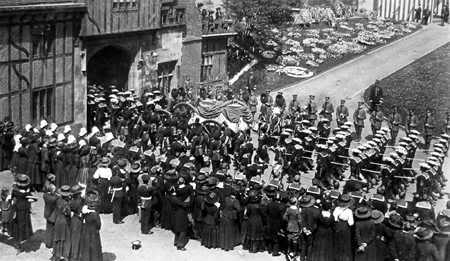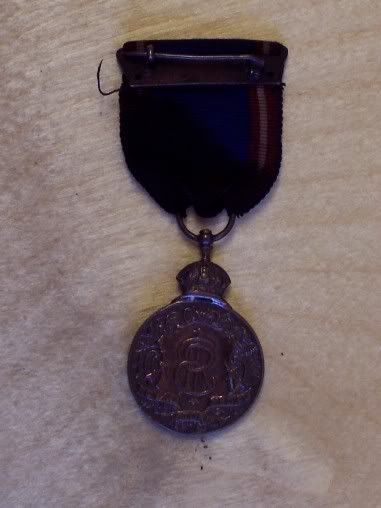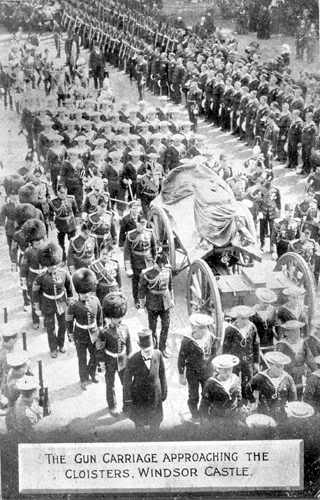I have always thought that it’s interesting, you can get a bit of silver or brass with just a name and a number, and if you dig hard enough you can find the guys whole life, from where he was born, to where he met his maker (sadly often in some foreign field).
I bought a medal quite a while back, it is a “Royal Victorian Medal”, awarded to one of the Grenadier Guards Pall bearers at Edward the VII’s funeral. With a bit of research I found out quite a bit about this extraordinary young mans forgotten life.
13789 Pte Harry Ward 1st Bn Grenadier Guards RVM MM
May his memory live on, as he had no chance too.
Harry was born in 275 Fereston (?) road, Radford Nottinghamshire around 1896, he had 3 older brothers, and 2 sisters (1 aged 15 and 1 aged 1).
When he was old enough, it would seem, that Harry joined the Army, the Grenadier Guards, 1st Bn, in 1910, along with 11 other Grenadier Guardsmen, he formed part of the honour Guard to march besides the coffin of Edward the Seventh. For this service Harry was awarded the Royal Victorian Medal in Bronze.
RVM (EdVII) Bronze: 7 June 1910
WARD, Harry. Pte King’s Coy. 1st Bn Grenadier Guards: HM Funeral
 [http://www.thamesweb.co.uk/windsor/w…Ifuneral.html]
[http://www.thamesweb.co.uk/windsor/w…Ifuneral.html]
2nd Bn Grenadier Guards:
4.8.14 Chelsea: 4th (Guards) Bde. 2nd Div. 15.8.14 Landed at Le Harve 20.8.15 to 1st Guards Bde. Guards Div.
On the 25th September 1917, 13789 Lcpl H.Ward of the 2nd Bn Grenadier Guards was awarded an MM for Bravery in the Field (hopefully the war diary will help to confirm what his actions were that lead to the award).
On the 1st December 1917 the 1st Guards division was at Cambrai, unfortunately Harry lost his life this day.
Name: WARD, HARRY
Initials: H
Nationality: United Kingdom
Rank: Lance Serjeant
Regiment/Service: Grenadier Guards
Unit Text: 2nd Bn.
Date of Death: 01/12/1917
Born In: Radford, Notts
Service No: 13789
Casualty Type: Commonwealth War Dead
Grave/Memorial Reference: Panel 2.
Memorial: CAMBRAI MEMORIAL, LOUVERVAL
“The Plan:
An attack on Cambrai using tanks was initially proposed by J.F.C. Fuller in June 1917 and almost simultaneously by Henry Hugh Tudor. Both plans were taken up by Julian Byng, Commander of the Third Army. Douglas Haig approved the plan as ‘Operation GY’ in September 1917, following another failure at Ypres. The Somme region was chosen for several reasons, one in particular for the tanks – the hope that the flatter, chalk terrain would be better for tanks than the deep clay slurry found by this time, on the Flanders Front.
The initial scope of the battle by Fuller, as reported by Liddell Hart, was for a raid “to destroy…demoralize and disorganize…and not to capture ground” taking eight to twelve hours with 9 battalions of tanks and at most three divisions of infantry or cavalry. Byng took the idea to Haig but the idea stalled initially with the focus on the battle at Ypres. By the time the focus shifted the raid had become a full-sized assault.
The plan was quite complex, but basically the German line would be broken by a concentrated attack across a narrow front (around five miles) between the Canal du Nord and St Quentin canal and then Cambrai would be encircled and Bourlon Ridge captured. Certain newly developed tactics would be employed, including the use of air interdiction and mixed infantry and tank formations. Cavalry was also included in the plan, expanding through a ‘cavalry gap’ towards the River Sensée. The assault was assigned to the divisions of the British Fourth Army; of these no fewer than ten were still recovering from the slaughter at Third Ypres. Their commander, Byng, was much more optimistic of the potential success than Haig. The defending force was part of the German Second Army under General Georg von der Marwitz, designated Gruppe Caudry (or XIII Corps) it initially consisted of the 20th, 54th, 9th Reserve and 183rd divisions.
The divisions of the British III and IV Corps were to lead the attack. III Corps would attack in the south (right) between Crèvecoeur and Bonavis, with cavalry divisions waiting to exploit the bridgehead to be formed around Marcoing and Masnières. IV Corps was to advance in the north (left), capturing Havrincourt, Flesquières, Graincourt and Cantaing before allowing reserve and cavalry divisions to take Bourlon and the significant ridge. V Corp was assigned to follow up these successes to take the ground up to the River Sensée and secure crossings. The Tank Corps (soon to be renamed the Royal Tank Regiment) under Brigadier Hugh Elles provided its entire strength, over 350 fighting Mark IV tanks for the first day of the battle, 476 in all over the course of the battle. There were 216 tanks in the initial advance with 96 in reserve. A certain few of the tanks were equipped with massive wood fascines to aid trench crossing or special ‘grapnels’ to aid wire removal. The first advances were mixed tank and infantry in ‘Tank Battle Drill’, with a leading tank echelon and then 50 yards back infantry platoons in two files, assigned as eight platoons per tank as either trench cleaners or trench ‘stop’. Fourteen Royal Flying Corps squadrons were assigned to the battle, to provide trench strafing and to cover the noise of the tanks’ advance.
The Attack:
The battle began at 0600 on 20 November. It opened with a carefully prepared and predicted but unregistered fire barrage by 1,003 guns on key German defences followed by smoke and a creeping barrage at 300 yards ahead to cover the first advances. Despite efforts to preserve secrecy, the German forces had received sufficient intelligence to be on moderate alert: an attack on Havrincourt was anticipated, as was the use of tanks.
Initially there was considerable success in most areas, and it seemed as if a great victory was within reach; the Hindenburg Line had been successfully penetrated with advances of up to 8 km achieved. On the right, the 12th (Eastern) Division advanced as far as Lateau Wood before digging in was ordered; the 20th (Light) Division forced a way through La Vacquerie and then advanced to capture a key bridge across the St Quentin canal at Masnières. The fate of the bridge is unclear. It was certainly destroyed but that was either by German demolition or by the weight of tanks attempting to pass over it. Whatever the cause it halted the hopes for advance there. In the centre the British captured Ribécourt and Marcoing, but when the cavalry passed through, late, they were dealt a sharp blow and fell back from Noyelles.
In the centre the 51st (Highland) Division was stalled at its first objective, Flesquières, and left the advances around it exposed. It is believed that the commander of the 51st, G.M. Harper, substituted his own tank drill for the standard one and that an excessive space between the tanks and the infantry contributed to the failure. Flesquières was also one of the strongest points in the German line and was flanked by other strong points. Its defenders under Major Krebs also acquitted themselves well against the tanks, engaging them aggressively. Almost forty tanks were knocked out by the Flesquières artillery, including sixteen by a single gun manned by a lone gunner.[citation needed] Despite this the Germans were forced to abandon Flesquières during the night.
British tank crossing a trenchOn the left the 62nd (2nd West Riding) Division swept all the way through Havrincourt and Graincourt to within reach of the woods on Bourlon Ridge and the 36th (Ulster) Division on their left reached the Bapaume-Cambrai road. Of the tanks 180 were out of action after the first day, although only 65 had been destroyed. Of the remainder 71 had suffered mechanical failure and 43 had been ‘ditched’. The British had suffered around 4,000 casualties and had taken 4,200 prisoners, a casualty rate half that of Third Ypres (Passchendaele), and a greater advance in six hours than in three months there.
However the British had failed to reach the heights of Bourlon Ridge. The German command was quick to send up reinforcements overnight and was relieved that the British did not manage to fully exploit their early gains. When the battle was renewed on the 21st the pace of British advance was greatly slowed. The abandoned Flesquières and then Cantaing were captured in the very early morning but in general the British took to reinforcing their gains rather than expanding. The efforts of III Corps were officially halted and attention was turned to IV Corps.
The continuing effort was aimed at the ridge. Fighting was fierce around Bourlon and at Anneux, just before the woods, was very costly. German counters squeezed the British out of Moeuvres (21st) and Fontaine (22nd). Even when Anneux was taken the 62nd found themselves unable to even enter Bourlon Woods. The British were left exposed in a salient. Haig still wanted Bourlon Ridge and the exhausted 62nd Division was replaced by the 40th Division under John Ponsonby on the 23rd. Supported by almost a hundred tanks and 430 guns the 40th attacked into the woods of Bourlon Ridge on the morning of the 23rd. They made little progress. The Germans had put two divisions of Gruppe Arras on the ridge with another two in reserve, Gruppe Caudry was reinforced and to challenge the RFC the squadrons under the Red Baron were assigned. The British 40th did reach the crest of the ridge but were held there and suffered over 4,000 casualties for their efforts in three days.
More British troops were pushed in to move beyond the woods to Fointaine. But the British reserves were rapidly depleted and the Germans were still sending in more reinforcements. The final British effort was on the 27th by the 62nd Division aided by thirty tanks. Early success was soon reversed by a German counterattack. The British now held a salient roughly 11 km by 9.5 km with its front along the crest of the ridge. On the 28th the offensive was officially ended and the British troops were ordered to lay wire and dig in. The Germans were quick to concentrate their artillery on the new British positions. On the 28th over 16,000 rounds were fired into the wood.
Counter Attack:
As the British used up their strength to take the ridge the Germans were reinforcing the area more generally. As early as the 23rd the German command felt that a British breakthrough would not occur and began to consider a counter-offensive. 20 divisions were arrayed in the Cambrai area. The Germans intended to retake the Bourlon salient and also to attack around Havrincourt while diversionary attacks would hold IV Corps. Overall it was hoped to at least reach the old positions on the Hindenburg Line. The Germans intended to employ the new tactics of a short, intense period of shelling followed by a rapid assault using Hutier infiltration tactics, leading elements attacking in groups rather than waves and bypassing strong opposition. For the initial assault at Bourlon three divisions of Gruppe Arras under Otto von Moser were assigned.
The German attack began at 0700 on 30 November. Almost immediately the majority of III Corps divisions were heavily engaged. Gruppe Caudry attacked from Bantouzelle to Rumilly and aimed for Marcoing. Gruppe Busogny was targeted from Banteux. The initial speed of the German infantry’s advance was completely unexpected by the British. The commands of 29th and 12th divisions were almost captured, with Brigadier-General Vincent having to fight free from his own encircled headquarters and then grab men from any retreating units to try to halt the Germans. In the south the German advance spread across eight miles and came within a few miles of the vital village of Metz and its link to Bourlon. At Bourlon itself the men under Moser met with stiffer resistance. The British had assigned eight divisions worth of fire support to the ridge and the Germans suffered heavy casualties. Despite this the Germans closed and there was fierce fighting. British units displayed reckless determination – one group of eight British machine guns fired over 70,000 rounds in their efforts to stem the German advance around Bourlon.
The concentration of British effort to hold the ridge was impressive but allowed the German advance elsewhere greater opportunities. Only the fortunate arrival of British tanks and the fall of night allowed some form of line to be held. By the following day the impetus of the German advance was lost, but continued pressure on 3 December led to the German capture of La Vacquerie and the withdrawal of the British from the east of the St Quentin canal. The Germans had reached a line looping from the ridge at Quentin to near Marcoing. Their capture of Bonvais ridge made the British hold on Bourlon precarious.”
http://en.wikipedia.org/wiki/Battle_of_Cambrai_%281917%29
Hopefully now you can see that far from being just a bit of bronze or brass or silver, these medals can give you a mans complete life story…….. wasn’t this mans sacrifice worth remembering? I think so.




